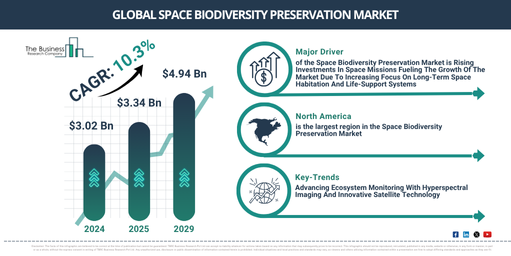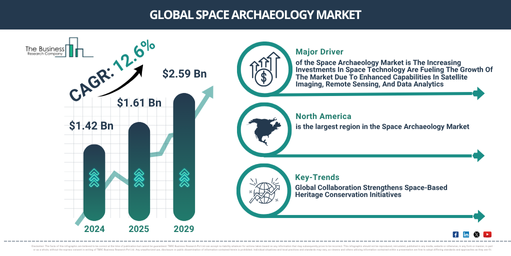How Fast Is the Space Biodiversity Preservation Market Growing? Forecast Through 2029
Limited Offer: Get Comprehensive Trade & Market Analysis at 20% Off – Use Code ONLINE20
What Are The Forecasted Market Size Figures For The Space Biodiversity Preservation Market From 2024 To 2029?
The market focused on safeguarding biodiversity within outer space has experienced swift expansion lately, projected to climb from its 2024 valuation of $3.02 billion to $3.34 billion by 2025, reflecting a compound annual growth rate of 10.6%; this upward trend during the past period stems from a greater frequency of space undertakings, escalating capital infusions into life science studies, broadening worldwide partnerships, enhanced satellite-based Earth observation tools, and a greater need for established planetary defense measures.
Anticipation points toward a swift expansion of the market dedicated to safeguarding biodiversity in space, projected to reach a valuation of $4.94 billion by 2029, driven by a compound annual growth rate (CAGR) of 10.3%. This upward trajectory over the forecast horizon is largely fueled by escalating governmental financial support for these initiatives, the proliferation of seed repositories hosted in orbit, an increase in multinational agreements governing space activities, greater investment in extraterrestrial agricultural studies, and the expansion of endeavors involving the general public in scientific data collection. Key shifts expected to define this period incorporate ongoing technological breakthroughs, enhancements in remote observational methods, the deepening integration of artificial intelligence systems, evolution in satellite communication infrastructure, and progress concerning research apparatus operating in microgravity environments.
Download Your Free Report Sample:
https://www.thebusinessresearchcompany.com/sample.aspx?id=25583&type=smp
What Long-Term Growth Drivers Will Sustain The Space Biodiversity Preservation Market?
Anticipated escalations in funding dedicated to space endeavors are projected to fuel the expansion of the space biodiversity preservation sector in the future. Space missions constitute meticulously planned endeavors undertaken outside the terrestrial atmosphere utilizing artificial satellites or spacecraft, intended for exploration, investigation, or making technological leaps. The escalating financial commitments toward these space missions are motivated by the quest for sophisticated technologies that enhance homeland security, foster scientific breakthroughs, and unlock commercial potential. Such greater financial support for space activities directly aids in safeguarding biodiversity beyond Earth by facilitating the creation of supportive environments and tools necessary for observing and safeguarding life forms in non-terrestrial settings. To illustrate this trend, data from the National Aeronautics and Space Administration, an autonomous US organization, indicates that NASA’s financial allocation is slated to increase, moving from $25.384 billion in 2024 to $26.40 billion by 2027. Consequently, the augmenting financial input into space operations serves as a clear impetus for the market growth in preserving biodiversity within the space domain.
What Are The Major Product Segments Of The Space Biodiversity Preservation Market?
The space biodiversity preservation market covered in this report is segmented –
1) By Technology: Cryopreservation, Seed Banks, Genetic Engineering, Other Technologies
2) By Application: Space Missions, Space Colonization, Research And Development, Other Applications
3) By End-User: Government Agencies, Private Space Companies, Research Institutions, Other End Users
Subsegments:
1) By Cryopreservation: Embryo Cryopreservation, Sperm And Egg Cell Preservation, Tissue Cryobanking, Plant Cell And Seed Cryostorage, Cryogenic Freezers And Storage Systems
2) By Seed Banks: Space-Based Seed Storage, Heritage Crop Seed Collections, Genetically Modified Seed Vaults, Automated Seed Retrieval Systems, Climate-Resilient Seed Libraries.
3) By Genetic Engineering: Gene Editing, Synthetic Biology Applications, Transgenic Organism Development, Genomic Data Storage And Analysis, Bioinformatics Platforms For Biodiversity
4) By Other Technologies: Bio-Encapsulation And Biobanking, In Vitro Propagation, Microgravity Biological Preservation Systems, Artificial Intelligence In Biodiversity Management, Robotic Sample Handling Systems
What Innovation Trends Are Shaping The Future Of The Space Biodiversity Preservation Market?
Leading firms within the market dedicated to maintaining biodiversity are channeling efforts into creating sophisticated technological tools, notably high-definition hyperspectral cameras, with the aim of boosting ecosystem surveillance, achieving finer granularity in data specific to various species, and facilitating evidence-based conservation planning.This sophisticated imaging instrument surpasses conventional RGB three-color sensors or standard multispectral setups by acquiring information across a spectrum spanning hundreds to well over a thousand narrow, adjacent spectral regions.As a concrete example, the Chilean firm Lemu introduced Lemu Nge in August 2024; this 6U hyperspectral nanosatellite stands as the world’s inaugural satellite solely dedicated to tracking our planet’s biological diversity.Equipped with its advanced hyperspectral camera, this satellite delivers analytical detail exceeding that of conventional Earth observation satellites by more than twentyfold, allowing for in-depth examination of plant life and surface characteristics.Operating from Low Earth Orbit (LEO), it gathers essential information pertaining to ecological systems, how land is utilized, and where different species reside, thereby becoming instrumental in furthering worldwide preservation initiatives and closing current deficiencies in biodiversity data.
Which Companies Are Shaping The Competitive Landscape Of The Space Biodiversity Preservation Market?
Major Companies operating in the space biodiversity preservation market are Maxar Technologies Inc., Planet Labs PBC, ICEYE Ltd., EarthDaily Analytics Inc., Spire Global Inc., Pixxel Space Technologies Pvt. Ltd., Satsure Pvt. Ltd., Pachama Inc., GeoVille GmbH, NorthStar Earth & Space Inc., Asterra Inc., Satellogic Inc., SkyWatch Space Inc., Eleaf, Satelligence B.V., Farmonaut Pvt. Ltd., Genvision Geo Pvt. Ltd., PlanetWatchers Ltd., LiveEO Inc., Spottitt GmbH.
View The Detailed Report For More Insights
Which Region Leads The Space Biodiversity Preservation Market In Terms Of Revenue?
North America was the largest region in the space biodiversity preservation market in 2024. The regions covered in the space biodiversity preservation market report are Asia-Pacific, Western Europe, Eastern Europe, North America, South America, Middle East, Africa.
Request Your Customized Report Here:
https://www.thebusinessresearchcompany.com/customise?id=25583&type=smp
Browse Through More Reports Similar to the Global Space Biodiversity Preservation Market 2025, By The Business Research Company
Space Debris Removal Global Market Report 2025
https://www.thebusinessresearchcompany.com/report/space-debris-removal-global-market-report
Environment Conservation And Wildlife Organizations Global Market Report 2025
Space Debris Monitoring And Removal Global Market Report 2025
Get in touch with us:
The Business Research Company: https://www.thebusinessresearchcompany.com/
Americas +1 310-496-7795
Asia +44 7882 955267 & +91 8897263534
Europe +44 7882 955267
Email us at [email protected]
Follow us on:
LinkedIn: https://in.linkedin.com/company/the-business-research-company
YouTube: https://www.youtube.com/channel/UC24_fI0rV8cR5DxlCpgmyFQ
Global Market Model: https://www.thebusinessresearchcompany.com/global-market-model



